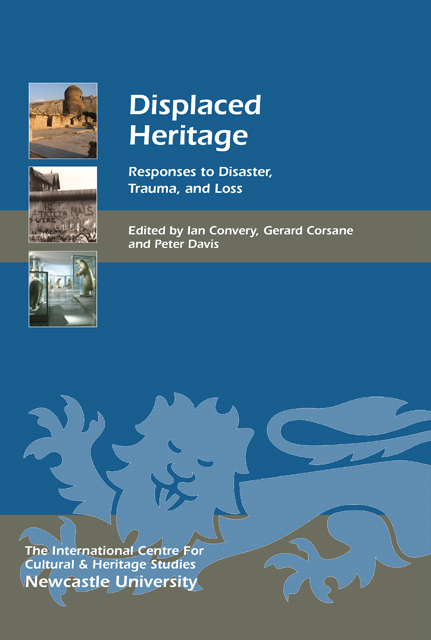Book contents
- Frontmatter
- Contents
- List of Illustrations
- Acknowledgments
- List of Abbreviations
- Preface
- Introduction
- Displaced Heritage: Histories and Tourism
- Displaced Heritage: Trauma, Confinement and Loss
- Displaced Heritage: Lived Realities, Local Experiences
- Displaced Natural Heritage
- Endpiece
- List of Contributors
- Index
- Heritage Matters
5 - Displaced Heritage and Family Histories: Could a Foreign Family’s Heritage in China Become an Ecomuseum ‘Hub’ for Cultural Tourism Management?
Published online by Cambridge University Press: 24 February 2023
- Frontmatter
- Contents
- List of Illustrations
- Acknowledgments
- List of Abbreviations
- Preface
- Introduction
- Displaced Heritage: Histories and Tourism
- Displaced Heritage: Trauma, Confinement and Loss
- Displaced Heritage: Lived Realities, Local Experiences
- Displaced Natural Heritage
- Endpiece
- List of Contributors
- Index
- Heritage Matters
Summary
Introduction
This chapter introduces a personal (re)discovery of family heritage and history that has been ‘displaced’ and (re)placed in a number of ways in Wuhan over time. The key phase of the actual displacement of this family heritage took place around a period of human disaster, trauma and loss in the late 1930s and 1940s, brought about by war and conflict. Wuhan is the capital city of Hubei Province in the People’s Republic of China. Located at the confluence of the Han and middle reaches of the Yangtze Rivers, the area has a long and rich heritage. Its significance over time is noted in many of the historical accounts of Chinese and global history. Its geographical placement has meant that it has been a natural meeting point and ‘crossroads’ in central China; a transportation hub and an economic, commercial, cultural and political centre. In 1949, Wuhan City was established by the merging of Hanyang, Hankou and Wuchan urban settlements. Positioned on the north-east bank, where the rivers meet, Hankou (or Hankow, as the Chinese name has previously been romanised) remains a key port.
Two surviving buildings in Hankou, constructed in the first quarter of the 20th century, are linked to my family history and heritage. They have been connected to two businesses with which my paternal grandfather, Walter Hughes Corsane, was associated: the Hankow Ice Works and the Aerated Water Company. The first building, erected in 1918, was identified by Chinese researchers and the second, built in 1921, was identified by me (see below). Both were located in the French Concession, one of the five foreign concessions in Hankow. For various reasons, these buildings and their associated histories have undergone a certain amount of literal and figurative ‘displacement’ from the family heritage. The physical displacement of this family heritage took place following a period of human-made conflict, devastation, suffering and trauma that started in July 1937, with the invasion and subsequent occupation of China by Japan in the Second Sino-Japanese War. This human-made turmoil increased as this conflict became part of World War II and grew further due to internal civil strife and war within China itself, which continued until 1949.
This chapter outlines a personal ‘journey’ of recovering ‘displaced’ heritage. It covers some of the challenges associated with conducting family history research in today’s world.
- Type
- Chapter
- Information
- Displaced HeritageResponses to Disaster, Trauma, and Loss, pp. 51 - 62Publisher: Boydell & BrewerPrint publication year: 2014



